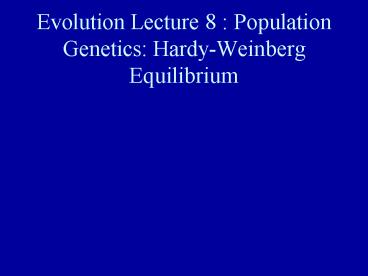Evolution Lecture 8 : Population Genetics: HardyWeinberg Equilibrium - PowerPoint PPT Presentation
1 / 10
Title:
Evolution Lecture 8 : Population Genetics: HardyWeinberg Equilibrium
Description:
... Lecture 8 : Population Genetics: Hardy-Weinberg Equilibrium. Population Genetics. Integrates evolution by natural ... The Null Model in Population Genetics ... – PowerPoint PPT presentation
Number of Views:209
Avg rating:3.0/5.0
Title: Evolution Lecture 8 : Population Genetics: HardyWeinberg Equilibrium
1
Evolution Lecture 8 Population Genetics
Hardy-Weinberg Equilibrium
2
Population Genetics
- Integrates evolution by natural selection with
Mendelian genetics - Changes in relative abundance of traits is tied
to the relative abundance of alleles that
influence them - Evolution here is the change in allele
frequencies across generations
3
The Null Model in Population Genetics
- We first need to see how allele frequencies
operate without selection, migration etc.. - This is a null model...a benchmark at which we
can compare changes in real populations due to
other factors - What is a population? A group of interbreeding
individuals and their offspring
4
How do we determine allele frequencies
- Example Examine a population of 43 individuals
for the Delta 32 gene - We have a total of 86 alleles
- If we have 16 heterozygotes and one homozygote
for the - allele, then we get a frequency of this
gene at 162/860.209 - The other ( allele) is 5216/860.791
- The frequency of both alleles must 1.0
- We could also do this by homo 26/430.605,
het 16/430.372, homo - 1/430.023. Therefore
the - allele freq. is 0.023 x 1/2 (0.372)0.209
5
Generic Life-Cyclefrom haploid to diploid.
Alleles taken from haploid stage as individual
genes are combined into the diploid stage
6
The allele frequency is 0.4 a and 0.6 A
7
By randomly plucking gametes and making zygotes,
we see that our frequencies change over time
8
Numerical Calculation
- If 60 of Eggs Contain A allele, and 60 Sperm
Contain A allele, then we can make predictions
about the probability of Zygotes - AA0.6x0.60.36
- Aa2(0.6x0.4)0.48
- aa0.4x0.40.16
- These must equal one
- If the population is in equilibrium, the
frequencies remained the same form generation to
generation
9
Hardy-Weinberg Equilibrium
- Yule thought that equilibrium meant that the
allele freq. must be 0.50 and 0.50 - Hardy demonstrated that they dont have to be
0.50/0.50, but simply must remain the same
between generations - if allele freq. are given by p and q, then the
genotypes can be calculated by p22pqq21 - Also,pq1
10
In Order for Equilibrium to be Maintained We
Assume
- No Selection
- No Mutation
- No Migration
- No chance events
- Random mating
- So, if allele freq. change from generation to
generation, and genotype freq. cannot be
calculated by multiplying allele freq., then one
of these assumptions is occurring...Evolution































